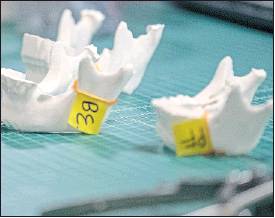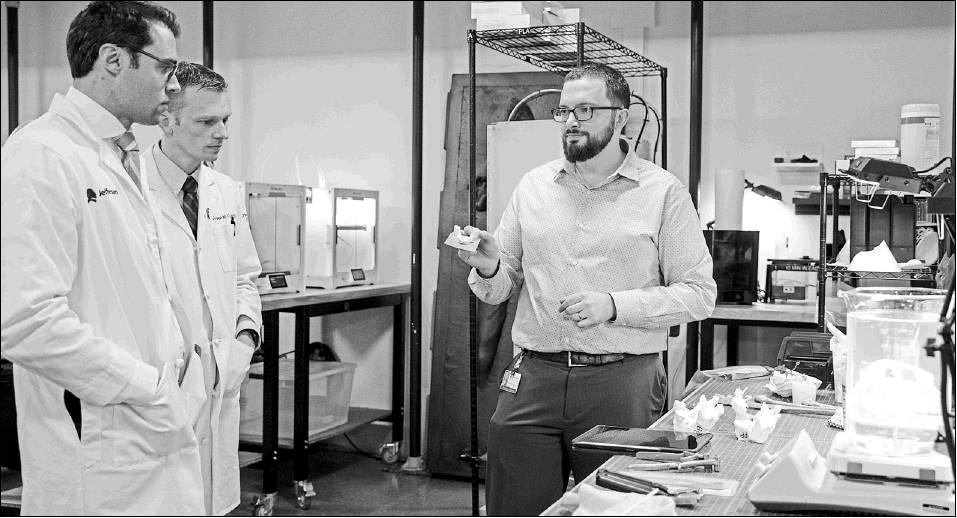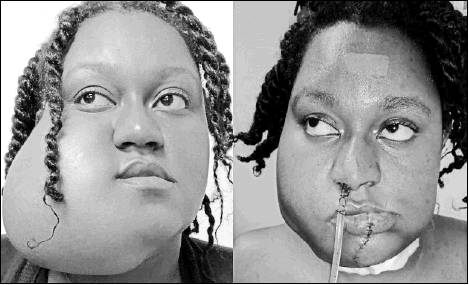HIGH-TECH MEDICINE
Haiti, the 3-D Way
Printers in Phila. help create models for surgery.
By Tom Avril STAFF WRITER
For five years, Jefferson University Hospital surgeons have been traveling to Haiti to rebuild the jaws of patients whose faces are disfigured by benign yet massive tumors. These are delicate operations, made all the more challenging because the doctors cannot see what they are dealing with until they arrive in a sparsely equipped operating room in Port-au-Prince and meet their patients.
This year they tried a new tactic: making models of the patients’ jaws in advance, with 3-D printers in Philadelphia.
The idea was to use the plastic models as a guide, allowing the physicians to bend titanium surgical plates in the exact shape of each patient’s jawbone — a task normally done during surgery. Shaping the plates in advance would save up to an hour in the operating room, reducing time under anesthesia, the risk of infection, and other complications, and it also would help the surgeons achieve a more faithful reconstruction of each patient’s original anatomy.
The concept is unusual even in the United States. Jefferson physicians have been making jaw models for this type of surgery only for the last year and a half, using a suite of printers housed in a former bank vault on Chestnut Street.
For patients in poverty-stricken Haiti, still recovering from the 2010 earthquake, the high-tech advance was like something from another world.
“It was life-changing,” said Patrick Jean-Gilles, head of the ear, nose, and throat/head and neck surgery department at Haiti State University Hospital.
Jean-Gilles sent discs containing three patients’ CT scans to Jefferson in early January, and Robert S. Pugliese, director of Jefferson’s Health Design Lab, got to work. Assisted by medical students, he converted the scans into computer files that could be interpreted by the lab’s printers. Then he kept watch for days as the printer nozzles glided back and forth, depositing layer after layer of plastic in the shape of the patients’ jaws and other facial bones.
Though invented decades ago, 3-D printers have only recently begun to transform medicine in various ways, as the cost of the boxy machines has declined. Some physicians use printed models of body parts as a visual aid, planning the best approach for surgery when a patient’s anatomy is especially complex. Others use printers to fashion actual devices to be implanted in a patient. Those typically are made from plastic and other inert materials, though increasingly, researchers are experimenting with devices that can “print” cartilage and other living tissue.
A printed model of a jawbone lies somewhere in between. It can help in visualizing the best strategy for a surgery, and it also serves as a template for bending the titanium plate that is screwed into what remains of a jaw eroded by a tumor.
Dominick Gadaleta, Jefferson’s chief resident for ear, nose, and throat/head and neck surgery, demonstrated the process last month, shaping a narrow strip of metal with a device that looked like a heavy-duty pair of pliers. He matched the metal’s curvature precisely to the contours of a jawbone model made from one of the Haitian patient’s scans.
“It’s a much better anatomical fit” than what can be achieved in the OR, Gadaleta said.
Jefferson surgeons have used this technique on two dozen U.S. patients so far, and they say it is especially useful for patients in Haiti, some of whose tumors are so large that the bone beneath has been destroyed. In the case of a 26-year-old Haitian woman whose right jaw was completely gone, physicians planned to bend the metal in a mirror image of her left jaw, said Joseph M. Curry, aJefferson head and neck surgeon who is a co-leader of the Haiti project.
The various benign tumors of the jaw are no more common in Haiti than in the U.S., but here they typically are removed while still small. In Haiti, where such surgeries were not readily available until recently, some patients’ tumors have grown to half the size of their faces. They need both a delicate tumor removal and also a complex reconstructive procedure that is not yet performed by Haitian physicians.
The growths are generally not painful, but patients can suffer from stigma, isolation, and difficulty eating and finding a job, Curry said.
Curry flew to Miami the night of Jan. 15, then caught an early-morning flight to Haiti the next day, the first of four days he would spend in the operating room at St. Luke’s Hospital in Port-au-Prince. He was one of a team of 20, including Jefferson surgeon David Cognetti, two surgeons from the University of Miami, and nurses, residents, and students from both institutions. Two of the group were there on a different mission: discussing a potential “telehealth” program through which Haitian physicians could consult their U.S. counterparts.
Eight patients underwent tumor removal and facial reconstruction surgery. The surgeons had 3-D-printed models in only two of the cases, as the necessary CT scans cost more than $300 — out of reach for many people in the impoverished country, Jean-Gilles said. A third 3-D-printed model had been made for a ninth patient, but the physicians were concerned that she might have cancer, and elected to postpone the surgery pending the results of a biopsy.
The surgeons occupied two operating rooms at St. Luke’s, tackling one case a day in each room. Some of the clinicians were tasked with cutting away the tumors while others handled the reconstruction. Jean-Gilles took part, as well.
On each patient’s jawbone, the surgeons screwed in a sterilized metal plate. In the two cases with the printed models, the plates had been custom-bent in advance.
Then the surgeons cut pieces from each patient’s fibula, the smaller of the two lower-leg bones, and attached those to the metal plates. (People can still walk with most of that bone removed.) With painstaking care, they attached the blood vessels in the implanted bones to veins and arteries in the patients’ necks. In the two cases where models were printed in advance, the time saved during surgery meant less time for the pieces of leg bone to go without oxygen, in addition to the other advantages. Each case took all day.
The team worked with limited resources. Unlike in the U.S., the patients did not undergo scans of their legs to ascertain the health of blood vessels before the surgeons removed the fibula. Because the patients were fairly young, the team decided it could omit that step, Curry said.
Also unlike in the U.S., the patients recovered with non-opioid pain medications. Opioids can suppress the respiratory system, and the Haitian hospital had limited technology to monitor the patients’ breathing rate. But the non-opioid alternative, though safer, provided less pain relief.
“They do remarkably well,” Curry said. “They’re not comfortable, but they’re OK.”
While all eight surgeries were successful, the surgeons achieved a better fit for the two patients whose jaw models had been printed in advance, Curry said.
“It’s giving them basically their old jawline back,” he said.
More than a week later, Jean-Gilles said seven of the patients were recovering well, though one developed an infection and will need a repeat surgery.
“All the other patients are eating now and so happy,” the Haitian surgeon said.
And with the knowledge gained from working alongside the Jefferson and Miami surgeons, Jean-Gilles plans eventually to undertake the complex reconstructive surgeries himself.
Maybe someday he could even get a 3-D printer. The machines used to print the jaw models cost $6,000 apiece, a hefty sum in Haiti.
But at Jefferson, lab director Pugliese said that because the printers have already saved so much time in the operating room, they already have paid for themselves. tavril@phillynews.com
215-854-2430
TomAvril1


